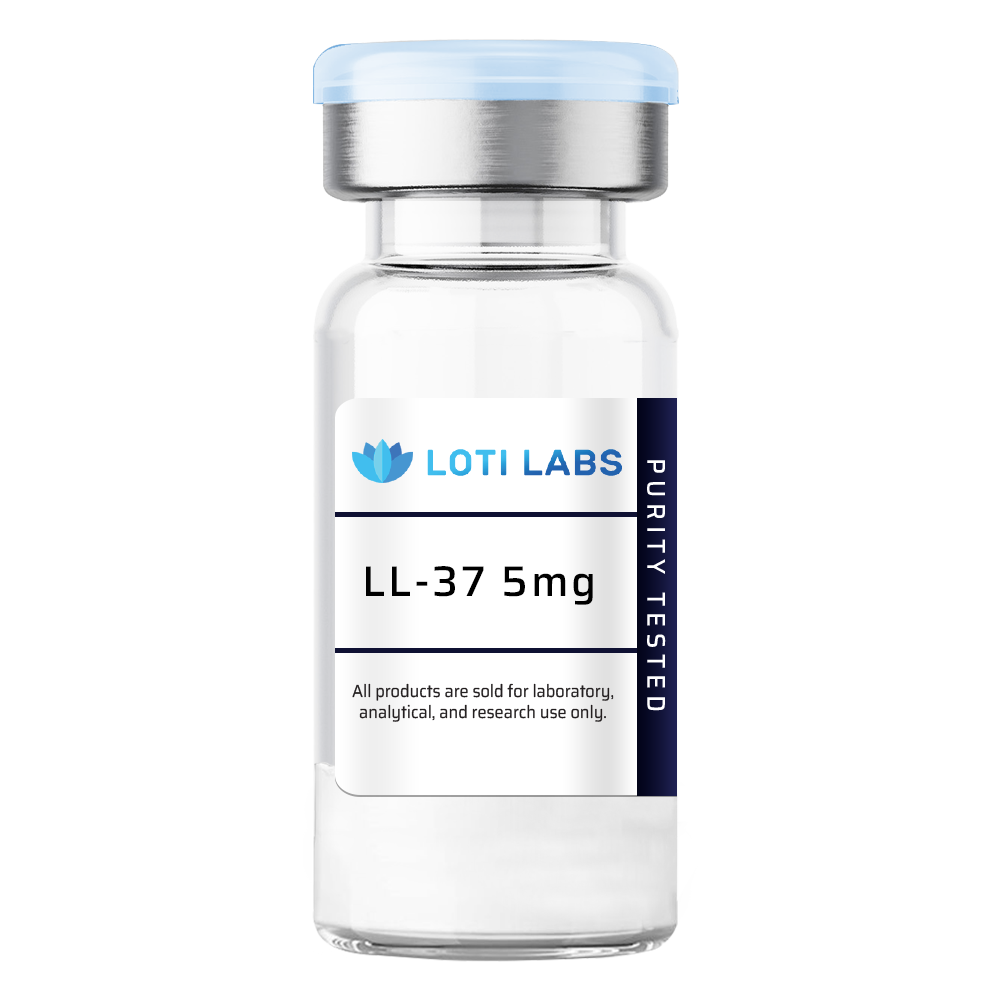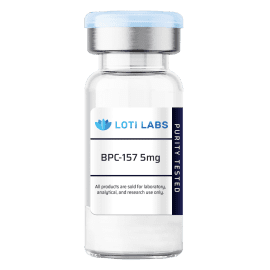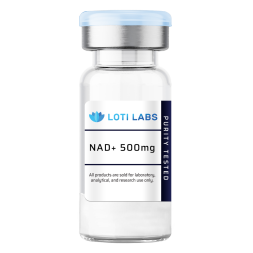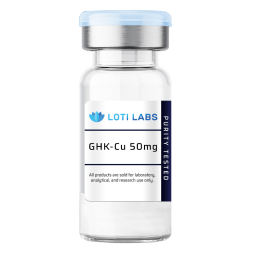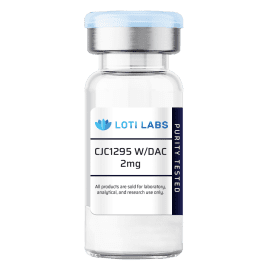LL-37 5mg
$94.99
You save

LL37 Peptide Buy: Purchase Top-Rated Antimicrobial Defense Peptide
Looking to purchase LL-37 peptide for research? This article will guide you on where to ll37 peptide buy genuine LL-37 peptide and what to consider for a quality purchase. Learn about its research applications and potential benefits.
Key Takeaways
- LL-37 is a key antimicrobial peptide that research suggests enhances the innate immune system and has broad-spectrum activity against various pathogens, making it a potential alternative to traditional antimicrobial substances.
- Research suggests LL-37’s significant roles in wound healing and immunomodulation, including promoting cell migration and regulating immune responses to maintain balance in inflammatory conditions.
- Loti Labs provides a reliable source for purchasing LL-37 peptide for research purposes, ensuring quality and adherence to strict usage guidelines to maintain research integrity.
Overview of LL-37 Peptide
LL-37 is a fascinating antimicrobial peptide derived from the C-terminal of human cathelicidin, a crucial component of the innate immune system. In research settings, this peptide has been observed to be synthesized by various immune cells, playing a critical role in the body’s defense mechanisms against infections. LL-37 belongs to a broader class of antimicrobial peptides that have captured significant scientific interest.
When examining its composition, researchers have identified that LL-37 contains a complex mix of basic residues like arginine (R), lysine (K), and histidine (H), alongside acidic residues such as aspartic acid (D) and glutamic acid (E). The structure also includes polar uncharged residues including glycine (G), serine (S), threonine (T), cysteine (C), asparagine (N), glutamine (Q), and tyrosine (Y). Specific sequences like arg asn leu val, ile val gln, leu gly asp phe, lys arg ile val, lys asp phe leu, phe arg lys ser, phe leu arg asn, and phe lys arg ile appear to be essential to how it functions in laboratory studies.
What makes LL-37 particularly interesting to scientists is its multifunctional role in host defense mechanisms. Beyond its antimicrobial activity, research suggests LL-37 demonstrates notable immunomodulatory functions, chemotaxis, wound healing, and angiogenesis capabilities. This peptide’s apparent ability to modulate immune responses and promote tissue repair in experimental models makes it a valuable subject for various research applications.
By understanding the fundamental properties of LL-37, researchers can explore new potential therapeutic avenues and expand our knowledge of innate immune responses. The story of LL-37 from a simple peptide to a multifaceted research tool showcases the hidden potential within these molecular structures.
Mechanism of Action
Understanding how LL-37 works is essential for appreciating its potential as a research compound. In laboratory settings, this cathelicidin-derived antimicrobial peptide has shown a broad spectrum of antimicrobial activity against various pathogens, making it an intriguing tool for infection studies.
Research Applications of LL-37
The versatile nature of LL-37 peptide has made it an exciting focus of research across various scientific disciplines. Its broad-spectrum antimicrobial properties, coupled with its apparent roles in wound healing and immune modulation, have opened numerous avenues for scientific exploration.
Scientists are particularly keen to understand how LL-37 might be studied to combat bacterial and viral pathogens, promote tissue repair processes, and regulate immune responses in research models.
Antimicrobial Properties
One of the most intriguing aspects of LL-37 is its broad-spectrum antimicrobial properties. Research suggests this peptide can effectively target both Gram-positive and Gram-negative bacteria in laboratory conditions, making it a versatile tool in the study of bacterial interactions. Its ability to disrupt microbial membranes appears to inhibit the growth of various pathogens, including fungi and viruses.
Laboratory studies have shown that LL-37 displays efficacy against multiple types of bacteria and fungi by disrupting their cell membranes – almost like popping tiny water balloons – thus preventing their proliferation. This mechanism positions LL-37 as a potential alternative to traditional antimicrobial compounds, especially relevant in the context of increasing antimicrobial resistance concerns.
Furthermore, research suggests that LL-37 can inhibit viral replication in experimental models, offering protective effects against various viral challenges. The antimicrobial activity of LL-37 extends beyond just targeting pathogens; it also appears to modulate immune responses to enhance natural defense mechanisms.
Understanding these properties enables researchers to explore novel strategies for antimicrobial research, potentially opening doors to new approaches for addressing resistant infections.
Wound Healing
Research suggests that LL-37 plays a crucial role in the body’s defense mechanisms against infections and in the healing process of wounds. Think of LL-37 as a construction foreman at a building site – studies indicate this peptide may enhance cell migration and stimulate tissue repair mechanisms, which are vital for effective wound closure and recovery in experimental models. Research suggests that this peptide may significantly accelerate wound healing by potentially promoting keratinocyte migration. Additionally, LL-37 appears to promote tissue repair by enhancing natural healing processes observed in laboratory settings.
LL-37 may not only facilitate cell migration but might also stimulate cellular proliferation, which is essential for restoring tissue integrity after injury in research models. Studies indicate that LL-37 might promote the formation of new blood vessels, a process known as angiogenesis, which is crucial for supplying nutrients and oxygen to healing tissue. This dual action of potentially promoting cell proliferation and angiogenic activity makes LL-37 an important factor in the study of wound healing processes.
Animal model studies have demonstrated the potential effectiveness of LL-37 in enhancing the wound healing process by promoting both keratinocyte migration and proliferation. These findings highlight the potential of LL-37 as a research tool that may help scientists better understand the underlying mechanisms of tissue repair.
Immunomodulatory Functions
Beyond its antimicrobial and wound healing properties, research suggests LL-37 exhibits significant immunomodulatory functions. Much like a thermostat regulates temperature, this peptide may play a dual role as both an antimicrobial agent and an immunomodulator, potentially influencing the activity of various immune cells. Studies suggest that LL-37 might modulate inflammatory responses by increasing the production of anti-inflammatory cytokines, thereby helping to regulate immune system balance in research settings.
Laboratory investigations indicate that LL-37 may enhance the activity of immune cells, such as neutrophils and macrophages, which are crucial for defense against infections. By potentially modulating the balance of pro-inflammatory and anti-inflammatory responses, LL-37 might help maintain immune function and reduce the severity of autoimmune conditions in experimental contexts.
The peptide LL-37 has also been observed in the pathogenesis of certain autoimmune conditions, as it can enhance type I interferon production in laboratory studies. This dual role of LL-37 as both a protective and pro-inflammatory agent underscores its importance in the study of immune responses and autoimmune diseases. Understanding these immunomodulatory functions can pave the way for new research strategies in studying immune-related disorders.
Benefits of LL-37 in Animal Studies
Research on LL-37 peptide in animal studies suggests its potential as a therapeutic agent for treating polymicrobial infections, particularly in chronic wounds. The peptide’s wide-ranging antibacterial and anti-biofilm properties make it a promising candidate for developing new antimicrobial substances. Studies suggest that LL-37 can enhance the innate immune response by promoting the production of pro-inflammatory cytokines and activating various immune cells, such as neutrophils and macrophages.
LL-37’s multifaceted roles in antimicrobial activity and inflammation make it a subject of extensive research. This peptide serves as a kind of “multi-tool” in the research toolkit – its potential ability to modulate immune responses and combat microbial infections highlights its importance as an alternative to traditional antimicrobial compounds. Researchers are also exploring LL-37’s role in the modulation of autoimmune diseases, further underscoring its significance in the study of immune response mechanisms.
The insights gained from animal studies on LL-37 can inform the development of new research strategies and enhance our understanding of the intricate interactions between the immune system and microbial pathogens. By leveraging the benefits observed in these studies, researchers can push the boundaries of peptide research and uncover new applications for LL-37.
Purchasing LL-37 Peptide from Loti Labs for Research
For researchers interested in exploring the potential of LL-37 peptide, Loti Labs offers a reliable source for purchasing this peptide exclusively for research and laboratory use. All products, including LL-37 peptide, are strictly intended for research purposes and are not for human consumption. Violations of this policy may result in being banned from future purchases.
Loti Labs provides a convenient online platform for purchasing LL-37 peptide, with free shipping available for orders over $99. Customers are required to reset their passwords after migrating to the new shopping cart system on the Loti Labs website, ensuring a secure and seamless shopping experience. Detailed information and guidelines for ordering peptides like LL-37 are readily available on the website.
Choosing Loti Labs as your supplier ensures the quality and authenticity of the LL-37 peptide, crucial for maintaining research integrity. The commitment to providing high-quality research peptides and adhering to strict usage guidelines makes Loti Labs a trusted partner for your scientific endeavors.
References and Further Reading
Relying on reputable sources for purchasing LL-37 peptide is essential to ensure the quality and authenticity of the peptides used in your studies. Reliable suppliers, such as Loti Labs, play a crucial role in maintaining research integrity and achieving effective research outcomes.
Factors to consider when purchasing LL-37 peptide include purity, concentration, and the reputation of the supplier. Ensuring these criteria are met can significantly impact the success of your research and the validity of your findings. References to scientific literature and PubMed IDs can provide valuable insights and further reading on the various applications and benefits of LL-37 peptide.
Numerous studies and reviews are available for those interested in delving deeper into the research use of LL-37, exploring its antimicrobial properties, immunomodulatory functions, and potential applications. These resources can serve as a foundation for expanding your knowledge and guiding your research endeavors.
Summary
In summary, LL-37 peptide stands out as a versatile and promising subject of research due to its broad-spectrum antimicrobial properties, wound healing capabilities, and immunomodulatory functions. Research suggests that this peptide’s multifaceted roles in the innate immune system highlight its potential as an alternative to traditional antimicrobial substances and a valuable tool for studying immune responses.
The benefits observed in animal studies underscore the potential of LL-37 as a compound for research into treating polymicrobial infections and enhancing tissue repair. By leveraging the insights gained from these studies, researchers can continue to explore new research strategies and expand our understanding of peptide-based interventions.
As we look to the future, the ongoing research on LL-37 peptide holds the promise of unveiling new applications and possibilities. The journey of LL-37 from a simple antimicrobial peptide to a multifaceted research tool exemplifies the potential hidden within these molecular structures, inspiring further exploration and innovation in the field of peptide research.
Frequently Asked Questions
What is LL-37 peptide?
LL-37 peptide is an antimicrobial peptide derived from human cathelicidin that research suggests significantly contributes to the innate immune system, offering broad-spectrum antimicrobial properties and aiding in wound healing and immunomodulation in laboratory settings.
Can LL-37 peptide be used for human consumption?
LL-37 peptide is strictly intended for research and laboratory use only and is not approved for human consumption.
What are the research applications of LL-37 peptide?
LL-37 peptide is utilized in research to explore its antimicrobial properties, its role in wound healing processes, and its immunomodulatory functions in immune response regulation and autoimmune conditions. This makes it a valuable compound for scientific investigation across various fields.
How can I purchase LL-37 peptide for research purposes?
You can purchase LL-37 peptide for research purposes from Loti Labs via their online platform, ensuring to follow their research-use-only policy. Free shipping is offered on orders exceeding $99.
What are the benefits of LL-37 peptide in animal studies?
Research suggests that LL-37 peptide has shown promise in animal studies as a compound against polymicrobial infections, exhibiting broad antibacterial and anti-biofilm properties, while also enhancing innate immune responses and providing insights into autoimmune disease mechanisms.
References and Further Reading
- Zaiou, M., & Gallo, R. L. (2002). Cathelicidins, essential gene-encoded mammalian antibiotics. Journal of Molecular Medicine, 80(9), 549-561. doi:10.1007/s00109-002-0350-5
- Dürr, U. H. N., Sudheendra, U. S., & Ramamoorthy, A. (2006). LL-37, the only human member of the cathelicidin family of antimicrobial peptides. Biochimica et Biophysica Acta (BBA) – Biomembranes, 1758(9), 1408-1425. doi:10.1016/j.bbamem.2006.03.030
- Nijnik, A., & Hancock, R. E. W. (2009). The roles of cathelicidin LL-37 in immune defences and novel clinical applications. Current Opinion in Hematology, 16(1), 41-47. doi:10.1097/MOH.0b013e32831ac517
- Kahlenberg, J. M., & Kaplan, M. J. (2013). Little peptide, big effects: the role of LL-37 in inflammation and autoimmune disease. Journal of Immunology, 191(10), 4895-4901. doi:10.4049/jimmunol.1302005
- Wang, G. (2014). Human antimicrobial peptides and proteins. Pharmaceuticals (Basel), 7(5), 545-594. doi:10.3390/ph7050545
- De Smet, K., & Contreras, R. (2005). Human antimicrobial peptides: defensins, cathelicidins and histatins. Biotechnology Letters, 27(18), 1337-1347. doi:10.1007/s10529-005-0936-5
- Nagaoka, I., Tamura, H., & Hirata, M. (2006). An antimicrobial cathelicidin peptide, human CAP18/LL-37, suppresses neutrophil apoptosis via the activation of formyl-peptide receptor-like 1 and P2X7. Journal of Immunology, 176(5), 3044-3052. doi:10.4049/jimmunol.176.5.3044
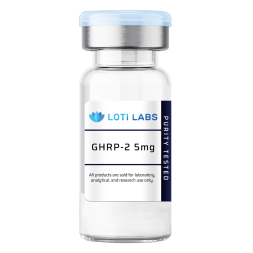 GHRP-2 5mg
GHRP-2 5mg 